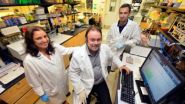(Press-News.org) CLEMSON, S.C. — New discoveries about how butterflies feed could help engineers develop tiny probes that siphon liquid out of single cells for a wide range of medical tests and treatments, according to Clemson University researchers.
The National Science Foundation recently awarded the project $696,514. It was the foundation's third grant to the project, bringing the total since 2009 to more than $3 million.
butterflyThe research has brought together Clemson's materials scientists and biologists who have been focusing on the proboscis, the mouthpart that many insects used for feeding.
For materials scientists, the goal is to develop what they call "fiber-based fluidic devices," among them probes that could eventually allow doctors to pluck a single defective gene out of a cell and replace it with a good one, said Konstantin Kornev, a Clemson materials physics professor. "If someone were programmed to have an illness, it would be eliminated," he said.
Researchers recently published some of their findings about the butterfly proboscis in The Journal of Experimental Biology.
They are now advancing to a new phase in their studies. Much remains unknown about how insects use tiny pores and channels in the proboscis to sample and handle fluid.
"It's like the proverbial magic well," said Clemson entomology professor Peter Adler. "The more we learn about the butterfly proboscis, the more it has for us to learn about it."
Kornev said he was attracted to butterflies for their ability to draw various kinds of liquids.
"It can be very thick like nectar and honey or very thin like water," he said. "They do that easily. That's a challenge for engineers."
Researchers want the probe to be able to take fluid out of a single cell, which is 10 times smaller than the diameter of a human hair, Kornev said. The probe also will need to differentiate between different types of fluids, he said.
The technology could be used for medical devices, nanobioreactors that make complex materials and flying "micro-air vehicles" the size of an insect.
"It opens up a huge number of applications," Kornev said. "We are actively seeking collaboration with cell biologists, medical doctors and other professionals who might find this research exciting and helpful in their applications."
The study also is breaking new ground in biology. While scientists had a fundamental idea of how butterflies feed, it was less complete than it is now, Adler said.
Scientists have long known that butterflies use the proboscis to suck up fluid, similar to how humans use a drinking straw, Adler said. But the study found that the butterfly proboscis also acts as a sponge, he said.
"It's a dual mechanism," Adler said. "As they move the proboscis around, it can help sponge up the liquid and then facilitate the delivery of the liquid so that it can then be sucked up."
As part of the study, researchers observed butterflies on flowers at the Cherry Farm Insectary just south of the main campus on the shore of Hartwell Lake. Butterflies were raised in the lab and recorded on video as they fed.
Researchers are turning their attention to smaller insects, such as flies, moths and mosquitoes, but the focus will remain on the proboscis.
In the next phase of the study, researchers would like to understand how the proboscis forms.
Larvae enter the pupa without a proboscis and emerge as a butterfly with one. Understanding what happens in the pupa could help develop the probes, Adler said.
Another challenge is figuring out how to keep the probe from getting covered with organic material when it's inserted into the body, he said.
That's why researchers are beginning to turn their focus to an insect almost everyone else shoos away.
"It seems the flies are able to pierce an animal's tissue, take up the blood and not get the proboscis gummed up and covered with bacteria," Adler said.
Tanju Karanfil, associate dean of research and graduate studies in the College of Engineering and Science, said the study has underscored the importance of breaking down silos that separate researchers from different departments so they can work for the common good.
"The most interesting work happens at the intersection of disciplines," he said. "In this case, biologists and engineers have come together with different perspectives to answer common questions.
"Their results are encouraging, and I look forward to seeing what they discover next."
INFORMATION:
This material is based upon work supported by the National Science Foundation under grant numbers IOS 1354956, EFRI 00937985 and PoLS 1305338. Any opinions, findings and conclusions or recommendations expressed in this material are those of the authors and do not necessarily reflect the views of the National Science Foundation.
Butterflies could hold key to probes that repair genes
2014-08-05
ELSE PRESS RELEASES FROM THIS DATE:
PET/CT using FDG-labeled leucocytes may detect infection in acute pancreatitis patients
2014-08-05
Reston, Va. (August 5, 2014) – A new study diagnosing infection in patients with pancreatic fluid collections may swiftly and accurately rule out active infection in the body. As reported in the August issue of The Journal of Nuclear Medicine, this treatment may assist in bringing nuclear medicine to the forefront of clinical management.
Acute pancreatitis (AP) is a sudden inflammation of the pancreas. It can have severe complications and high mortality despite treatment. While mild cases of AP are often successfully treated with conservative measures, such as nil per ...
Kaiser Permanente study finds shingles vaccine remains effective after chemotherapy
2014-08-05
PASADENA, Calif., August 5, 2014 — The herpes zoster vaccine continues to be effective in protecting older adults against shingles, even after they undergo chemotherapy, according to a Kaiser Permanente study published today in the journal Clinical Infectious Diseases.
Researchers examined the electronic health records of more than 21,000 Kaiser Permanente patients in Southern California who were 60 years of age and older and received chemotherapy between January 2007 and December 2012.
Researchers found that those patients who were previously vaccinated with zoster ...
Electronic cigarettes: many questions, limited research
2014-08-05
August 5, 2014 – Electronic cigarettes (ECIGs) are booming in popularity—but there's still only limited evidence on their potential health risks, or their advertised benefits in helping people to quit smoking, according to a research review in the July/August Journal of Addiction Medicine, the official journal of the American Society of Addiction Medicine. The journal is published by Lippincott Williams & Wilkins, a part of Wolters Kluwer Health.
Based on their review, Alison B. Breland, PhD, of Virginia Commonwealth University, Richmond, and colleagues, write, "[V]ery ...
Genetic testing of tumor is recommended for colorectal cancer patients
2014-08-05
Bethesda, MD (Aug. 5, 2014) — Of the 143,000 patients diagnosed with colorectal cancer annually in the U.S., up to 25 percent have a familial risk of colorectal cancer. A new guideline from the U.S. Multi-Society Task Force on Colorectal Cancer recommends genetic testing of tumors for all newly diagnosed colorectal cancer patients. The task force makes specific surveillance and management recommendations for those affected by a genetic condition called Lynch syndrome, the most common cause of inherited colorectal cancer, accounting for approximately 3 percent, or more than ...
NASA sees heavy rain in Hurricane Iselle as it heads toward Hawaii
2014-08-05
NASA's Tropical Rainfall Measuring Mission satellite known as TRMM flew directly over the eye of powerful Hurricane Iselle and found extremely heavy rainfall rates occurring there.
On August 4, 2014 at 1037 UTC (6:37 a.m. EDT) when TRMM passed over the storm, Iselle had winds of about 120 knots (about 138 mph) at that time making it a dangerous category four hurricane on the Saffir-Simpson hurricane wind scale. Rainfall from TRMM's Microwave Imager (TMI) and Precipitation Radar (PR) instruments was overlaid on an enhanced infrared image from NOAA's GOES-West satellite ...
A new 'whey' to control diabetes
2014-08-05
Blood sugar surges — after-meal glucose "spikes" — can be life threatening for the 29 million Americans with diabetes. Diabetic blood sugar spikes have been linked to cardiovascular disease, cancer, Alzheimer's disease, kidney failure, and retinal damage. Now a new Tel Aviv University study, published in Diabetologia, suggests a novel way to suppress these deadly post-meal glucose surges: the consumption of whey protein concentrate, found in the watery portion of milk separated from cheese curds, before breakfast.
According to TAU's Prof. Daniela Jakubowicz and Dr. Julio ...
Pump up the music -- especially the bass -- to make you feel powerful
2014-08-05
August 5, 2014 - It's the day of the big game – before heading out to the field, you put on your headphones and blast some music to pump you up. The music seemingly empowers you to do great things. This effect is not all in your head – according to new research, music truly does make us feel powerful. But not all songs have the same effect, researchers found, and the levels of bass are a key factor in their effectiveness.
"When watching major sports events, my coauthors and I frequently noticed athletes with their earphones on while entering the stadium and in the locker ...
Cancer fighter can help battle pneumonia
2014-08-05
AUGUSTA, Ga. – The tip of an immune molecule known for its skill at fighting cancer may also help patients survive pneumonia, scientists report.
A synthesized version of the tip of tumor necrosis factor appears to work like a doorstop to keep sodium channels open inside the air sacs of the lungs so excess fluid can be cleared, according to a study published in the American Journal of Respiratory Critical Care Medicine.
This TIP peptide is attracted to the sugar coating at the mouth of the sodium channel. Once the two connect, they move inside the small but essential ...
Planet-like object may have spent its youth as hot as a star
2014-08-05
Washington, D.C.—Astronomers have discovered an extremely cool object that could have a particularly diverse history—although it is now as cool as a planet, it may have spent much of its youth as hot as a star.
The current temperature of the object is 200 to 300 degrees Fahrenheit (100 to 150 degrees Celsius), which is intermediate between that of the Earth and of Venus. However, the object shows evidence of a possible ancient origin, implying that a large change in temperature has taken place. In the past this object would have been as hot as a star for many millions ...
What drives cybersex addiction among female internet pornography users?
2014-08-05
New Rochelle, NY, August 5, 2014 -- Women who visit Internet pornography sites are at risk of developing cybersex addiction. A comparison of the tendency toward cybersex addiction among heterosexual women who do or do not use Internet pornography and factors predictive of developing cybersex addiction are described in a study published in Cyberpsychology, Behavior, and Social Networking, a peer-reviewed journal from Mary Ann Liebert, Inc., publishers. The article is available free on the Cyberpsychology, Behavior, and Social Networking website.
In "Cybersex Addiction ...



